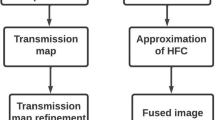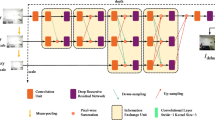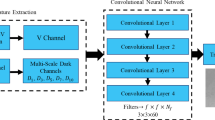Abstract
Foggy weather prominently causes degradation in visibility due to the scattering of the atmospheric particles. Consequently, there arises a problem in identification of the precise object features by the human eye as well as the machine based computer vision systems. To encounter such situations, various adept mechanisms are required. The proposed scheme attempts to encompass the deep learning approach for the amalgamation of the RGB and Infra-red imaging in order to improve the vision quality of the hazy images. A fused image is obtained via intelligent conjunction of significant information from both the imaging schemes. Subsequently, the combined image is processed using a Dark Channel Prior algorithm and a bilateral filtering is used to maintain the edge information. Comparative results using various quality parameters including entropy, Standard Deviation, Similarity Index, and Peak Signal to Noise Ratio signifies that the proposed fusion scheme performs better than contemporary single image de-hazing algorithms.
Access this chapter
Tax calculation will be finalised at checkout
Purchases are for personal use only
Similar content being viewed by others
References
Ministry of Road Transport & Highways, Government of India. https://morth.nic.in/. Accessed 22 Feb 2021
Fan, X., Wang, L.: Image defogging approach based on incident light frequency. Multimed. Tools Appl. 78(13), 17653–17672 (2019). https://doi.org/10.1007/s11042-018-7103-1
Narasimhan, S.G., Nayar, S.K.: Vision and the atmosphere. Int. J. Comput. Vis. 48, 233–254 (2002)
Nayar, S.K., Narasimhan, S.G.: Vision in bad weather. In: Proceedings of the IEEE International Conference on Computer Vision, pp. 820–827. IEEE (1999)
Jin, X., et al.: Infrared and visual image fusion method based on discrete cosine transform and local spatial frequency in discrete stationary wavelet transform domain. Infrared Phys. Technol. 88, 1–12 (2018)
Vanmali, A.V., Gadre, V.M.: Visible and NIR image fusion using weight-map-guided Laplacian-Gaussian pyramid for improving scene visibility. Sadhana - Acad. Proc. Eng. Sci. 42, 1063–1082 (2017)
Sharma, V., Hardeberg, J.Y., George, S.: RGB-NIR image enhancement by fusing bilateral and weighted least squares filters. J. Imaging Sci. Technol. 61, 1–9 (2017)
Wang, X., Nie, R., Guo, X.: Two-scale image fusion of visible and infrared images using guided filter. In: ACM International Conference Proceeding Series, pp. 217–221. Association for Computing Machinery, New York (2018)
Bavirisetti, D.P., Dhuli, R.: Two-scale image fusion of visible and infrared images using saliency detection. Infrared Phys. Technol. 76, 52–64 (2016)
Han, X., et al.: An adaptive two-scale image fusion of visible and infrared images. IEEE Access. 7, 56341–56352 (2019)
Umbgen, F.D., El Helou, M., Gucevska, N., Usstrunk, S.S.: Near-Infrared Fusion for Photorealistic Image Dehazing (2018)
Li, S., Kang, X., Hu, J.: Image fusion with guided filtering. IEEE Trans. Image Process. 22, 2864–2875 (2013)
Liang, J., Zhang, W., Ren, L., Ju, H., Qu, E.: Polarimetric dehazing method for visibility improvement based on visible and infrared image fusion. Appl. Opt. 55, 8221 (2016)
Brown, M., Susstrunk, S.: Multi-spectral SIFT for scene category recognition. In: Proceedings of the IEEE Computer Society Conference on Computer Vision and Pattern Recognition, pp. 177–184. IEEE Computer Society (2011)
Anwar, M.I., Khosla, A.: Vision enhancement through single image fog removal. Eng. Sci. Technol. Int. J. 20, 1075–1083 (2017)
Khan, A., Sohail, A., Zahoora, U., Qureshi, A.S.: A survey of the recent architectures of deep convolutional neural networks. Artif. Intell. Rev. 53, 5455–5516 (2021). https://doi.org/10.1007/s10462-020-09825-6
Mathew, A., Amudha, P., Sivakumari, S.: Deep learning techniques: an overview. In: Hassanien, A.E., Bhatnagar, R., Darwish, A. (eds.) AMLTA 2020. AISC, vol. 1141, pp. 599–608. Springer, Singapore (2021). https://doi.org/10.1007/978-981-15-3383-9_54
Tyagi, V.: Understanding Digital Image Processing. CRC Press, Boca Raton (2018). https://doi.org/10.1201/9781315123905
Acknowledgment
The research work was funded by Technical Education Quality Improvement Program (TEQIP-III) under Collaborative Research Scheme project titled: Development of Fusion based Defogging Technique for visibility improvement.
Author information
Authors and Affiliations
Corresponding author
Editor information
Editors and Affiliations
Rights and permissions
Copyright information
© 2021 Springer Nature Switzerland AG
About this paper
Cite this paper
Singh, S., Baba, A.M., Anwar, M.I., Moon, A.H., Khosla, A. (2021). Visibility Improvement in Hazy Conditions via a Deep Learning Based Image Fusion Approach. In: Singh, M., Tyagi, V., Gupta, P.K., Flusser, J., Ören, T., Sonawane, V.R. (eds) Advances in Computing and Data Sciences. ICACDS 2021. Communications in Computer and Information Science, vol 1440. Springer, Cham. https://doi.org/10.1007/978-3-030-81462-5_37
Download citation
DOI: https://doi.org/10.1007/978-3-030-81462-5_37
Published:
Publisher Name: Springer, Cham
Print ISBN: 978-3-030-81461-8
Online ISBN: 978-3-030-81462-5
eBook Packages: Computer ScienceComputer Science (R0)




